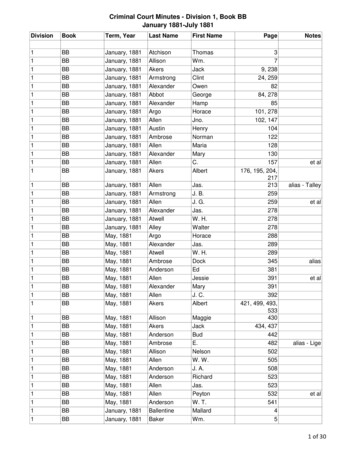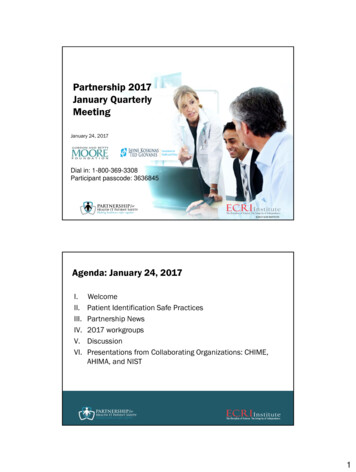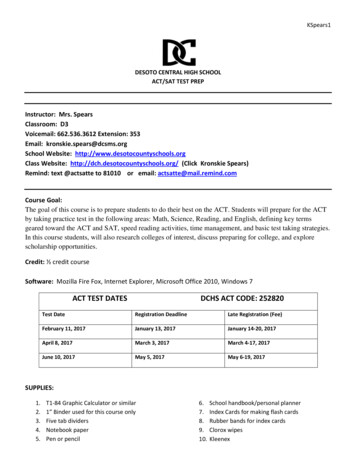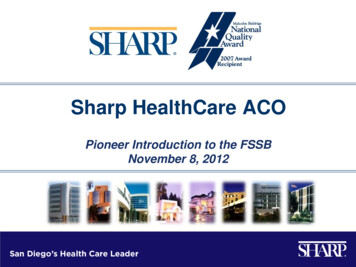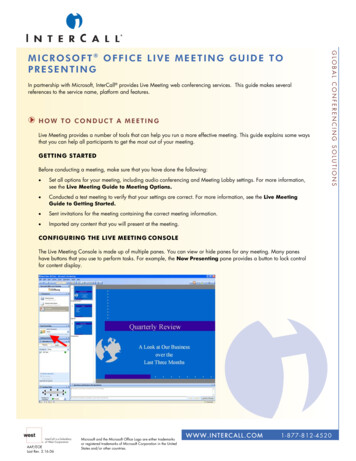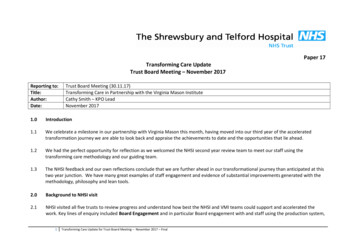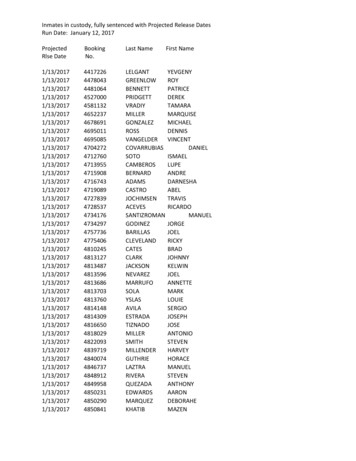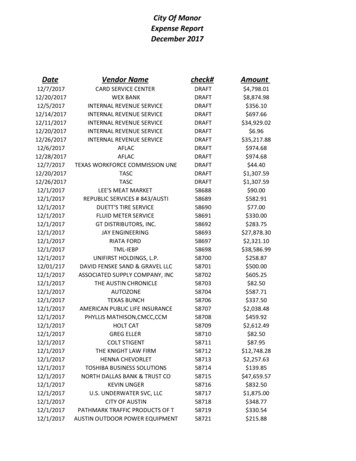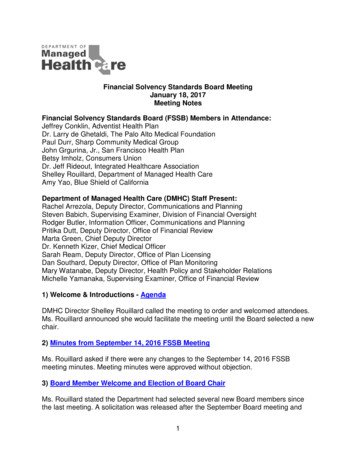
Transcription
Financial Solvency Standards Board MeetingJanuary 18, 2017Meeting NotesFinancial Solvency Standards Board (FSSB) Members in Attendance:Jeffrey Conklin, Adventist Health PlanDr. Larry de Ghetaldi, The Palo Alto Medical FoundationPaul Durr, Sharp Community Medical GroupJohn Grgurina, Jr., San Francisco Health PlanBetsy Imholz, Consumers UnionDr. Jeff Rideout, Integrated Healthcare AssociationShelley Rouillard, Department of Managed Health CareAmy Yao, Blue Shield of CaliforniaDepartment of Managed Health Care (DMHC) Staff Present:Rachel Arrezola, Deputy Director, Communications and PlanningSteven Babich, Supervising Examiner, Division of Financial OversightRodger Butler, Information Officer, Communications and PlanningPritika Dutt, Deputy Director, Office of Financial ReviewMarta Green, Chief Deputy DirectorDr. Kenneth Kizer, Chief Medical OfficerSarah Ream, Deputy Director, Office of Plan LicensingDan Southard, Deputy Director, Office of Plan MonitoringMary Watanabe, Deputy Director, Health Policy and Stakeholder RelationsMichelle Yamanaka, Supervising Examiner, Office of Financial Review1) Welcome & Introductions - AgendaDMHC Director Shelley Rouillard called the meeting to order and welcomed attendees.Ms. Rouillard announced she would facilitate the meeting until the Board selected a newchair.2) Minutes from September 14, 2016 FSSB MeetingMs. Rouillard asked if there were any changes to the September 14, 2016 FSSBmeeting minutes. Meeting minutes were approved without objection.3) Board Member Welcome and Election of Board ChairMs. Rouillard stated the Department had selected several new Board members sincethe last meeting. A solicitation was released after the September Board meeting and1
FSSB Meeting NotesJanuary 18, 2017over 20 responses were received. The Department looked for a mix of experience andperspectives including actuarial experience, health and medical economics, and healthcare administration.Ms. Rouillard announced the reappointment of Dr. Larry de Ghetaldi and asked thefollowing new board members to introduce themselves: Jeffrey Conklin, Adventist Health Plan Paul Durr, Sharp Community Medical Group John Grgurina, San Francisco Health Plan Amy Yao, Blue Shield of CaliforniaMs. Rouillard announced Betsy Imholz had agreed to serve as the Board Chair. Therewere no objections from the Board.4) Director’s RemarksMs. Rouillard provided an update on DMHC’s recruitment efforts. The DMHC hired fiveDeputy Directors in the past three months and now has a fully-staffed Executive Team.The new Deputy Directors include: Elizabeth Landsberg, Deputy Director, Help Center Drew Brereton, Deputy Director, Office of Enforcement Pritika Dutt, Deputy Director, Office of Financial Review Sarah Ream, Deputy Director, Office of Plan Licensing Dan Southard, Deputy Director, Office of Plan MonitoringIn addition, the DMHC appointed Dr. Ken Kizer as its Chief Medical Officer. Dr. Kizerwill advise the Department on clinical matters and develop the Department’scomprehensive health plan quality improvement program to drive improvement inclinical outcomes for health plan enrollees.Ms. Rouillard reviewed the DMHC’s 2015 Annual Report, which was released inOctober. The report highlights the key accomplishments and statistics for each office,including summary statistics for Independent Medical Reviews (IMRs) and complaintsby health plan.5) 2016-17 Governor’s Budget UpdateMarta Green, Chief Deputy Director, discussed the Governor’s budget for the 20172018 fiscal year. The proposed budget includes nearly 77 million in total spending2
FSSB Meeting NotesJanuary 18, 2017authority for the DMHC and 451 authorized positions. This is a net increase of fivepositions over the prior fiscal year.The Department has four Budget Change Proposals (BCPs) for the upcoming fiscalyear, three that add funding and positions and one that reduces funding and positions.The BCPs include: The Help Center Case Backlog and Workload BCP adds eleven permanent andfive limited-term positions. It includes a budget augmentation of 3.4 million inthe 2017-18 fiscal year and ongoing funding of 2.6 million. The Information Technology (IT) and Resource BCP will support DMHC’s ITfunctions related to the growth of the Department. This BCP equates to fundingof 746,000 for the upcoming fiscal year and an ongoing budget of 289,000. The Prohibition on Surprise Balance Billing BCP is associated with theimplementation of Assembly Bill (AB) 72, which prohibits surprise balance billingwhen an enrollee receives services at an in-network hospital and receives asurprise bill because one of the treating physicians or other personnel was not innetwork. This BCP adds 16 permanent staff, which equates to 3.5 million in the2017-18 fiscal year and ongoing funding of 2.2 million. The vast majority of theadded positions will be allocated to the Help Center to run the IndependentDispute Resolution Process (IDRP) and the Office of Plan Monitoring, which willmonitor the implementation of AB 72. The Medicaid Managed Care Final Rule BCP proposes a reduction of 18.5permanent staff and a budget reduction of 3.4 million in the 2017-18 fiscal yearand an ongoing reduction of 2.9 million. The BCP terminates four interagencyagreements with the Department of Health Care Services (DHCS), who will takeon monitoring functions required by the federal government in the Final Rule.This reduction will mostly pertain to the Office of Plan Monitoring and a few in theOffice of Financial Review and the Help Center, but there will be no layoffs. Thereductions will be absorbed through attrition and vacancies.DiscussionBetsy Imholz stated the Help Center is one of the jewels of the DMHC and asked howthe Department will handle the potential onslaught of calls during these uncertain timesand the confusion that will likely follow. Ms. Green explained the Help Center hasundergone a significant reorganization to increase efficiency and reduce redundancy ofwork. The streamlined processes, in addition to the positions associated with the BCPs,will help the DMHC remain flexible in responding to whatever comes.Amy Yao requested clarification regarding the redundant activities associated withDHCS. Ms. Green replied the activities the Department was conducting on behalf ofDHCS, such as conducting surveys or network reviews, will no longer be conducted byDMHC.3
FSSB Meeting NotesJanuary 18, 2017Anthony Wright, Health Access California, expressed his organization’s appreciation ofthe investments in implementing AB 72 and added the ultimate goal is the Help Centerwould no longer need to resolve complaints pertaining to surprise medical billing. Mr.Wright questioned the reduction of three Help Center positions since the number ofMedi-Cal enrollees that contact the Help Center is relatively small. Ms. Green clarifiedthat there are about 140 staff in the Help Center, but the three positions in questionwere to administer the Coordinated Care Initiative (CCI) Ombudsman Program not toprovide direct consumer assistance.Dr. Jeff Rideout asked how restrictive the AB 72 resources are and if they could beused to assist with other consumer issues. Ms. Green said the resources are primarilyintended to administer the IDRP program required by AB 72. She added the elevenpositions associated with the Help Center BCP will give the Help Center the appropriateresources to handle incoming complaints.Bill Barcellona, CAPG, stated the Department has had an on-going balance billingprotection since 2007 that uses the Gould criteria for balance billing related to ERservices. Mr. Barcellona asked if the DMHC has considered how it might combine theIDRP processes. He also asked if there will now be two standards for payment or if theDMHC will blend the two. Mary Watanabe, Deputy Director, Health Policy andStakeholder Relations, answered the DMHC envisions the binding arbitration processfor AB 72 will be separate from the IDRP process for emergency services. Ms.Watanabe indicated there will stakeholder engagement taking place before July 1.6) National Trends in Individual and Small Group PremiumsDonna Novak, NovaRest Actuarial Consulting, presented an overview of how Californiacompares to other states in several areas, including rate increases and their drivers,components of final premium rates, number of carriers per rating area, and riskadjustment.Ms. Novak stated California had the lowest rate increases, including the lowest overallaverage increase in both the individual and the small group markets in 2017.Ms. Novak explained metal level is particularly important in the individual marketbecause the silver metal level is what determines the subsidy for lower incomeenrollees and if someone doesn’t get a subsidy and can only afford the bronze level, thelowest cost tier is also important. She made the following observations about metal tiersin the individual market: California had one of the lowest average increases at the bronze level. At the silver tier, there was a big difference between the states with a lowincrease versus a high increase and California was close to the states with thelowest increase.4
FSSB Meeting NotesJanuary 18, 2017 California had the second lowest increase in both the gold and platinum tier.Ms. Novak noted the following observations regarding the small group market: California had the lowest increase in the bronze and silver tiers. California tied for the lowest increase in the gold tier. At the platinum level, one state had a reduction in their rates, followed byCalifornia with the lowest average increase.Ms. Novak noted that her company looks at hundreds of rate filings and what is drivingrate increases. By far, the largest impact has been the trend, but there are other factorssuch as changes in administrative cost, non-benefit expenses and worsening morbidity.The end of the reinsurance program also increased rates slightly across the board. Inaddition, some carriers projected their experience to be lower than what it really was, sothey were underpriced and therefore had larger rate increases.California was in the middle when looking at trends in the individual market, which isamazing considering the rate increases were so low. California had the lowest trend inthe small group market.California had the second lowest profit margin percentage. However, when you look atprofit margin on a per member per month (PMPM) basis, California had the lowest profitmargin in both the individual and small group market.Ms. Novak compared rates for a 21 year old by market and tier. The reason age 21 isused is because it is an age factor of one. This comparison is also adjusted by cost ofliving because it is expected that states with a high cost of living would have higherpremium rates. This is particularly relevant because California has the third-highest costof living of the fifty states. However, California had the lowest average rate in all tiers inboth the individual and the small group markets.She then compared the number of carriers offered per area on the Exchanges.California ranks second with an average of four carriers per region in the individualmarket and three per region in the small group market.Finally, Ms. Novak discussed risk adjustment and the problems caused by carriers whodon’t have the information to estimate their risk and the kind of risk adjustment they willhave to pay. California had the second highest risk adjustment transfer with 628.6million in the individual market and 327.5 million in the small group market.The Federal Government may be providing more detail in the future, but the informationmay not be timely or mature enough to be helpful as risk adjustment changes from yearto year. Population migration between plans is another problem. Plans are seeing5
FSSB Meeting NotesJanuary 18, 2017individuals change from carrier to carrier as the lowest cost silver plan changes, whichis creating a lot of swing in some parts of the market. In addition, individuals who wereallowed to keep their individual and small group plans are now transitioning into themarket and it is difficult to predict their morbidity or impact on the risk adjustment.DiscussionJohn Grgurina asked if the averages presented were an aggregate of all plans onExchange or if it was a weighted average. Ms. Novak answered it was a weightedaverage.Mr. Grgurina asked if the trends only included on-Exchange plans or if she also includedindividual products sold off of the Exchange. Ms. Novak said she believed they focusedjust on-Exchange and stated most of the time off-Exchange plans would use onExchange rates so the trend would be the same.Ms. Yao confirmed the industry uses the same trend data for both on-Exchange and offExchange, but the benefit levels and pricing can vary off-Exchange.Dr. Larry de Ghetaldi asked if there is a better way to understand the variation in therate increases within California’s regions. Ms. Novak explained one factor that controlsrates in different regions for a carrier is the geographic factor. She added that when theysee a change in the geographic factor they can ask questions to ensure the geographicfactors do not reflect morbidity and just reflect the cost of care in that area.Dr. Rideout stated the analysis done in the Integrated Healthcare Association’s (IHA’s)Statewide Cost and Quality Atlas confirms that even when adjusted for wages, there isstill a significant variation of 20 to 25 percent in the total cost of care in some regions.Dr. de Ghetaldi stated when a physician completes an encounter with a patient, theycomplete the medical record and assign an International Classification of Diseases(ICD)-10 and Current Procedural Terminology (CPT) code. Physicians have beentaught that the CPT code is what drives revenue, but the ICD-10 code is important,particularly in Medicare Advantage, for risk adjustment. An accurate diagnosis in theCovered California, individual and small group market may accurately identify morbidityand improve affordability and the opportunities for subsidies. If this is true, it couldchange the thinking of physicians.Ms. Novak responded that accurate coding will impact the risk adjuster, which impactsthe revenue because it is basically an adjustment to claims for the carrier and will havean ultimate impact on the premiums. Dr. de Ghetaldi stated this is a revelation for somethat have been in the healthcare industry for a long time that accurate coding isincreasingly important.Paul Durr asked if the variation between states would be as great if utilization were tobe normalized at a standard cost relative to the premiums. Ms. Novak responded it is6
FSSB Meeting NotesJanuary 18, 2017difficult to obtain accurate utilization and cost information because they usually get thebaseline with trends. They tried to account for some of that by normalizing for cost ofliving.Ms. Yao explained that California’s premium rates are lower than other states becauseCalifornia has one of the biggest populations and it is healthier overall. In addition,California started managed care a long time ago and providers have done a better jobof managing utilization compared to other fee-for-service states. In the small groupmarket, the California legislation that discouraged small employers from moving to selffunded kept healthier employer groups in the pool which has kept rates down.Ms. Imholz asked if the explanations carriers gave for rate increases is accurate. Ms.Novak responded it varies from carrier to carrier but they believe the carriers are doinga good job of isolating what is driving the rates increases.Ms. Imholz was surprised that plan design changes was number four on the list ofreasons for increases of 15 percent or more since Covered California has prettystandard designs. Ms. Novak clarified that this was across all states and some stateshave a lot more variation within each metal tier.Ms. Imholz asked if California was one of the states to receive the highest riskadjustment transfer because it has a big market or for some other reason. Ms. Novakstated that it could be an indication that some carriers are getting healthier individualsand other carriers are getting significantly less healthy individuals. Ms. Novak addedrisk adjustment does not compensate for the sickest individuals, meaning a carrier thatattracts very unhealthy individuals is being under-compensated by risk adjustment.Dr. Rideout stated there was one state that had 33 different silver plans and 26 of themwere from one carrier. The variation has narrowed, but it is still confusing forconsumers. Dr. Rideout added that while managed care deserves a lot of credit, theproposed rate increases by carrier that were presented at the September FSSB meetingshowed the carriers that had more integrated care had some of the lowest rateincreases. There is variation within managed care in terms of the degree of integration.Dr. de Ghetaldi stated he agreed that the early introduction of managed care inCalifornia had a positive downstream impact on utilization and total cost of care. Heasked if being one of the states with the highest risk adjustment has a negative impacton the plan. Ms. Yao said risk adjustment is good from her perspective because itallows plans to offer broad PPO networks and to have sicker patients. Without the riskadjustment, plans might eventually exit the market.Jeffrey Conklin asked if the variation in profitability was explained by the mix among themetal tiers or if it is truly a reflection on the plans. Ms. Novak explained the biggestdriver of profitability is if a plan has solvency issues and they have to make up for that inprofits. The medical loss ratio can’t be lower than 80 percent so there is a limit on how7
FSSB Meeting NotesJanuary 18, 2017much profit they can make. If a plan has a lot of reserves and surplus, a plan can becompetitive with a lower profit.Mr. Barcellona raised three issues for the Board to consider. First, there is an instancein San Francisco County where an unexpectedly high risk adjustment transfer hasresulted in a dispute by a capitated provider related to several million dollars in clawback of capitation. This is a good example of the impact of high rates of risk adjustmenttransfer on downstream risk-bearing providers.Mr. Barcelona stated this was a great presentation about the individual and small groupmarket, which represents about 1.5 to 1.8 million Exchange members. A similarpresentation for the large group market would be very interesting, particularly given thehuge erosion of HMO in the large group market over the last decade.Finally, Mr. Barcelona suggested the DMHC should present this information to themembers of Congress and the California Congressional delegation. The presentationshows California’s Exchange has had superior results over the last four years.Ms. Rouillard asked if it was possible to do a similar presentation for the large groupmarket. Ms. Novak responded that many states don’t gather information on the largegroup market and information is not readily available.7) Legislative UpdateMs. Watanabe provided a summary of the legislation implementation activities theDMHC has been involved in during the past year, as well as some that are yet to come.Ms. Watanabe stated the goal of Senate Bill (SB) 137 is to improve the accuracy ofprovider directories and to provide standardization across directories. Since the lastmeeting, the Department held a stakeholder meeting and released the first draft of thestandards on December 30, 2016. The plans have until January 1, 2018, to implementthe initial standards. There will be two opportunities to make changes to the standardsbefore promulgating regulations by January 1, 2021.Ms. Watanabe acknowledged Havi Jogani for working collaboratively with the CaliforniaDepartment of Insurance on the development of the initial provider directory standardsrequired by SB 137. It was quite an undertaking that proved to be very complex.SB 546 requires large group plans to file large group aggregate rate information withDMHC annually beginning October 1, 2016. Plans are also required to provideinformation in their notices to employers about how the rate increase compares to theaverage rate increase for Covered California and the California Public EmployeesRetirement System (CalPERS). SB 546 also requires the DMHC to hold an annualmeeting to discuss large group rates. The meeting is scheduled for February 1 in SanFrancisco.8
FSSB Meeting NotesJanuary 18, 2017Ms. Watanabe then reviewed AB 72, which takes effect on July 1, 2017, and prohibitssurprise balance billing. The DMHC is required to establish a methodology forcalculating the reimbursement rate to non-contracted providers by January 1, 2019. Therate paid to non-contracting providers will be the greater of the average contracted rateor 125 percent of the Medicare rate. AB 72 preserves the out-of-network benefit forthose in a PPO but they must give written consent 24 hours in advance.In addition, prior to July 1, 2017, plans must provide information to the DMHC abouttheir methodology for calculating the average contracted rate and their policies andprocedures. The DMHC will hold a stakeholder meeting in the spring. As discussed inthe budget presentation, the DMHC will also be establishing an IDRP process forservices provided by a non-contracted provider at an in-network facility.The final bill Ms. Watanabe discussed was SB 908, which extends the time period forplans to file their premium rate changes with the DMHC. It also requires a plan toprovide written notice to renewing groups, policyholders, or applicants when theDepartment determines a premium rate increase is unreasonable or unjustified.DiscussionMs. Yao stated rate review was not new for the DMHC and asked what the newrequirement was under SB 908. Ms. Watanabe responded that SB 908 extends the timeperiod for rate review from 60 days to either 100 or 120 days. Ms. Rouillard added theextended filing period in SB 908 will allow for more time to review and go back and forthwith the plans. It will also allow more time for the DMHC to consider the commentssubmitted by consumer advocates.Ms. Yao said while she understands the rationale, this will require the plans to developthe rates earlier than would be typical. This means they will have to use two monthsolder experience and the longer period they have to project out, the more risk in therates. This could create opportunities for corrections the following year.Dr. de Ghetaldi said it appears there will be two doors for IDRP – the traditional one foremergency services and the one created by AB 72. He added he would like to hearmore in a year from now about the volume and the conflicts that are seen. Ms.Watanabe committed to providing updates at future meetings.Ms. Imholz said there was a recent Journal of the American Medical Association(JAMA) article on the specialties that tend to have the greatest likelihood of surprisebills. She added that this is an issue of deep interest for Consumers Union, which has abig national campaign to end surprise medical bills. She asked that in addition toreporting on IDRP trends it would be good to also report on consumer complaints to geta full picture.Tim Madden, on behalf of the California chapter of the American College of EmergencyPhysicians (CalACEP) and California Society of Plastic Surgeons, asked what criteriawill be used by the arbiters for the IDRP required by AB 72. Ms. Watanabe responded9
FSSB Meeting NotesJanuary 18, 2017that there is a lot to be learned from the existing IDRP process but this would be part ofthe discussion during the stakeholder meeting. She suggested individuals interested inupdates should sign up for DMHC’s listserv or contact her directly for more informationabout the stakeholder meetings.Mr. Wright asked how the legislation implementation timelines intersect with the existingcorrective action plans, health plan mergers, and other activities related to providerdirectories and rate increases. Ms. Watanabe answered the DMHC has a requirementin one of the undertakings that involves unreasonable rate increases and they arelooking at the impact of SB 908. She also mentioned that through the undertakingsrelated to the Blue Shield/Care1st merger, there is an Advisory Committee that islooking at where the financial investment is needed to ultimately create a multi-plandirectory. Ms. Rouillard added the Advisory Committee is in the information gatheringstage but they are working on something that will be easy to use and useful for bothproviders to update their information and for plans to get information to populate theirdirectories.Mr. Barcellona said the delegated risk-bearing groups will need guidance on how theDMHC will require the addition of the adjuster to the 2015 base rates and what CPTcodes they will need to report on. He added historically when the Department hasrequested data from the delegated payers, it was a manual process. He encouraged theDepartment to consider an automated process for collecting the data through anautomated portal. Ms. Watanabe responded the DMHC anticipates about 400 entitieswill be filing and the DMHC will be working quickly to provide the necessary guidance.8) Website EnhancementsRachel Arrezola, Deputy Director, Communications and Planning, and Rodger Butler,Information Officer, Communications and Planning, presented an overview of the recentenhancements to the DMHC website including the health plan dashboard and the ratereview website.Ms. Arrezola said the DMHC launched the health plan dashboard last fall. The goal wasto centralize all the health plan data to make it easier for the public to find and to helpthe DMHC better utilize the data internally.Mr. Butler demonstrated the health plan dashboard, which is located on the DMHCwebsite at www.dmhc.ca.gov. The Dashboard includes data such as enrollment,consumer complaints, enforcement actions, and health plan finances. He showed howinformation for two like plans can be compared side by side. The Dashboard alsoprovides an aggregate market-wide view of the entire industry regulated by the DMHC.Ms. Arrezola then discussed the rate review enhancement project. She explained healthplans are required to file proposed premium rate changes for the individual and smallgroup markets with the DMHC. The DMHC reviews the proposed changes to ensurethey are supported by data, such as medical costs and trends. There is also an10
FSSB Meeting NotesJanuary 18, 2017opportunity for the public to provide comments to the Department. The goal of thisproject was to educate the public about the rate review program and to make it easier tonavigate the site.Mr. Butler demonstrated the premium rate review webpage. The page displays theamount saved per calendar year, as well as other educational and informational pages.Mr. Butler demonstrated how to access the filing details for each plan and where toleave comments. He also pointed out a new “stay informed” feature that will send an email notification when there is a new rate filing or a change in filing status.Mr. Butler showed the educational and informational section of the website, which nowincludes information and videos on topics such as the rate review process, the cost ofhealth care, how rates are developed, medical loss ratio and rebates. Mr. Butler pointedout that there is also a new enhanced key terms section and frequently asked question(FAQ) section.DiscussionDr. de Ghetaldi asked if the Dashboard links to the Office of the Patient Advocate (OPA)data because it would be helpful for consumers to link this with information aboutcustomer service and quality. Ms. Arrezola confirmed it does. She added theDepartment is looking at future enhancements that could bring in new datasets.Ms. Yao recommended also including data from the Department of Insurance (CDI) toprovide a comprehensive view of the California market. This was seconded by Ms.Imholz and Mr. Grgurina. Ms. Arrezola noted that, according to the most recent annualreport from California Health Care Foundation (CHCF), DMHC regulates 95 percent ofthe commercial market.The Board congratulated the Department on the improvements to the website and theability to easily find information in one place.Beth Abbott, Director, Office of the Patient Advocate, announced OPA’s recent releaseof its 2015 Complaint Data Report, which includes complaint information from DMHC,CDI, DHCS, and Covered California.8) Department of Health Care Services UpdateMari Cantwell, Chief Deputy Director, Health Care Programs and State MedicaidDirector, DHCS, provided several updates about the Department, particularly related tothe recent release of the Governor’s budget. The DHCS budget is projected to be 105billion in the 2017-2018 fiscal year, which includes about 20 billion in General Fund.This is an increase of 10 billion from the prior fiscal year and a contributing factor tothe deficit the Governor spoke about in his budget presentation.11
FSSB Meeting NotesJanuary 18, 2017Ms. Cantwell stated the Coordinated Care Initiative (CCI) requires the mandatoryenrollment of dual eligibles into managed care and the integration of long term servicesand support in seven counties. The statute contains a poison pill trigger that if theDepartment of Finance (DOF) finds the program is not cost effective, it will becomeinoperative the following January. In determining the cost effectiveness of the program,the DOF looked at the fiscal components of the program, including the increased cost ofin-home supportive services (IHSS) over time and found that the program is not costeffective. Therefore, the poison pill is activated and would result in CCI ceasing inJanuary 2018.DHCS believes in the program and the long term benefits of integration in reducinginstitutional care and bringing individuals back into the community. The Governorproposed keeping the programmatic aspects of CCI but rem
The Prohibition on Surprise Balance Billing BCP is associated with the implementation of Assembly Bill (AB) 72, which prohibits surprise balance billing when an enrollee receives services at an in-network hospital and receives a surprise bill because one of the treating physicians or other personnel was not in- network.
